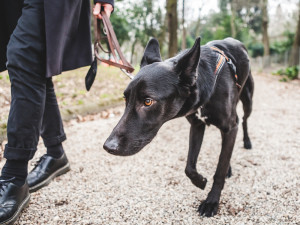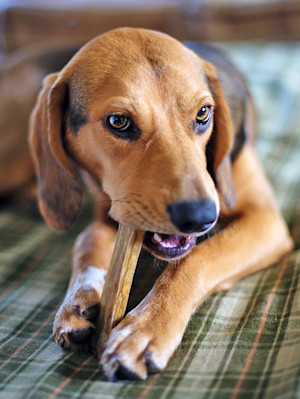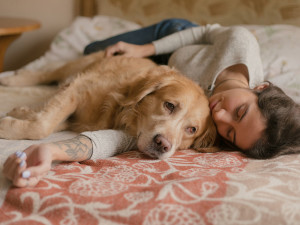75% of People Can’t Spot When Their Dog Is Worried – Are You One of Them?
Rolling on their back doesn’t automatically mean they want belly rubs...

Share Article
Dogs wagging their tails is entry-level dog behaviour stuff. We all know how to read it: wagging tail equals happy dog… right?
For those of you clearing your throat to perform your very best ackchyuallyopens in new tab, we’ll save you the trouble. No, a wagging tail doesn’t always equal a happy dog. In fact, it can mean something quite different indeed.
According to UK charity Dogs Trust biggest national survey yetopens in new tab (this year they received feedback from 373,216 dog parents about 430,406 pups), 80 percent of dog parents said they were ‘confident’ in reading dog body language. However, when it came down to the line, only 24 percent of respondents could consistently spot behaviour that showed their dog was worried. This means that over three-quarters of us pup parents are getting it wrong when our dogs are trying to show us they’re nervous. Eeks!
The most misinterpreted behaviour from respondents to the survey was dogs rolling over on their backs. “Many people think that this means a dog wants a belly rub,” says Dogs Trust. “But sometimes, by rolling on to their side or back, a dog may be trying to show that they pose no threat. This body language is also known as an ‘appeasement roll’ and can be a way for a dog to say they’re nervous about a situation.”
Elsewhere, a third of survey respondents thought that a wagging tail always meant a dog was happy when in actual fact, the truth is more complicated. According to US-based behaviourist Karen B London, a wagging tail means the dog is willing to interact. “The thing is, ‘interact’ is a very broad term,” she writes for Kinship. “Friendly dogs who want to interact by greeting, playing or snuggling wag their tails, but so do dogs who want to interact by fighting, biting and threatening. The simple observation that a dog is wagging their tail doesn’t give you enough information to determine what kind of interaction the dog has in mind.”
So, now you’ve had everything you thought you knew about dog behaviour upended, just how are you meant determine if your dog is worried? Having this knowledge isn’t important just so you can comfort them (although you should do this too!), it could help you and your dog avoid a potentially dangerous situation. “You need to know your dog well enough to recognise the signs that they are uncomfortable or worried,” says Dogs Trust. “You can then take appropriate action to protect the welfare of your dog, and to prevent the situation from getting worse.”
Every dog is different, so unfortunately there is no one-size-fits-all guide to spotting a worried dog says Dr Valli Parthasarathyopens in new tab, a veterinary behaviourist working in Portland, Oregon.
Some signs of anxiety are less obvious, like widened eyes, dilated pupils and a lowered tail. But, just as it does among people, Dr Parthasarathy says, “the specific combination of signs will differ between dogs and may change depending on the situation”.
Signs your dog is anxious
Dogs Trust, being the excellent dog parent pal that they are, have an extensive guide (with pics) to spotting anxiety in dogs body languageopens in new tab. If your dog exhibits any of the below postures then it’s worth stopping for a moment to consider what, if anything, your dog’s trigger is. You can then make a decision on how to handle the situation or whether to remove them from it altogether.
Keep an eye out for your dog...
Slowing down: this may indicate that they are unsure and trying to understand better what they’re up against. Their body might get tense, their ears may move back, tail lower or tongue flick out as they assess.
Leaning away: this literal rejection of whatever is concerning them might come along with yawning, narrowed eyes and lip licking.
Crouching down: shifting their body weight backwards with a tucked tail, a tense, closed mouth and furrowed brow could all be signs that your dog is trying to make themselves look as insignificant as possible to the perceived threat. However, it’s important to remember that some dogs might hold their tail straight upright instead to communicate loudly that they’re feeling unsure.
Lifting a paw: stopping and raising a paw can show apprehension.
Approaching with a lowered body: this could mean your dog wants to investigate but they’re apprehensive. This might be where the not-happy tail wagging comes in, along with a low head and eyes fixed on the trigger.
Performing an ‘appeasement grin’: not to be mistaken for an aggressive display of teeth, this facial expression is meant to be submissive. The edges of the mouth are pulled up in a ‘smile’, eyes are squinted and ears are held back.
Other, more common signs that your dog is feeling anxious include:
excessive barking and howling
excessive whining
aggression
panting or drooling excessively
digging or scratching repetitively
depression
pacing or restlessness
compulsive behaviours like unusual chewing
urinating or defecating in the house
trembling or shaking
What should I do if my dog is worried?
Armed with all your new knowledge, you might now notice instances where your dog is nervous that you hadn’t clocked before. It it’s a situational thing (out on a walk, big flapping bit of tarp on a building site ahead), remove them from the situation and either avoid that particular trigger in future or consider working with a behaviourist to alleviate their fear. Do not force your dog into situations that make them feel uncomfortable in the hope they’ll get over it. Overcoming a fear is a slow process that requires patience.
If you notice your dog is displaying signs of worry more generally and on a regular basis, your first port of call should be your veterinarian to check there’s nothing more serious going on. If your pup gets the clean bill of health, you may want to seek out a behaviourist to work with your dog on some of their fears. It’s essential this trainer deals in positive reinforcement. Fear-based trainers could make things much, much worse.
At the end of the day, it’s natural for your dog to show signs of worry now and again – after all, don’t you get a little anxious from time to time (or, you know, all the time)? But learning to recognise signs of anxiety and fear in your dog is a huge first step. And the fact that you’ve taken the time to figure it out is a great example of you having their back and supporting them when worry does strike. After all, you’re their person!

Jess Commons
Jess is a writer, editor and former global lifestyle director at Refinery29 with previous stints at ITV, Grazia, The Debrief (RIP) and more. She is a sucker for an older gentleman cat with A Past and spends most of her time being told what to do by her toddler and her three-legged rescue cat, Mac.
Related articles
![a close up picture of a beagle chewing a chew]()
Making Short Absences Easy: How To Leave Your Dog Home Alone
Scientists from the Waltham Petcare Institute explain how one simple buy could help your nervous pup feel more comfortable by themselves
Does Your Dog Need Anti-Anxiety Meds?
How to cope with dog anxiety – from training to medication
![Dog running on the beach]()
Can I Take My Anxious Dog On Holiday?
Think a holiday with your nervous pup is off-limits? You just need to make a few adjustments. Here’s how to have a dreamy trip that you and your anxious dog can enjoy
![A woman wearing a knit sweater holding a dog close on the floor of her bedroom.]()
Separation Anxiety in Dogs
Train your dog to stay calm when they’re on their own – instead of sad-singing “All By Myself” until you come home.
![Greyhound dog lying on top of couch looking out of a window]()
6 Calming Products That Help My Dog’s Anxiety
Compression vests, interactive toys and pheromone sprays will be game-changers for nervous pups








